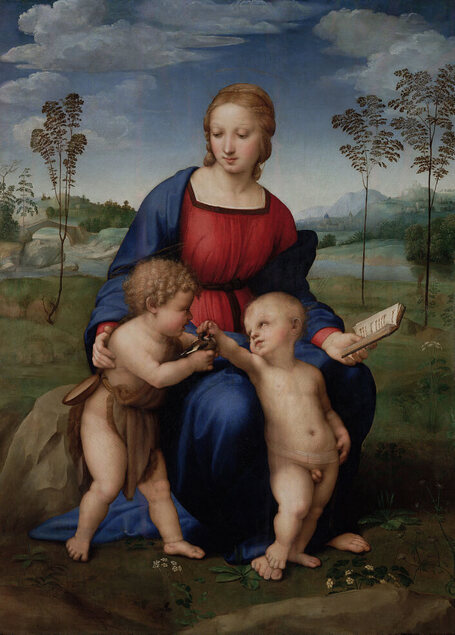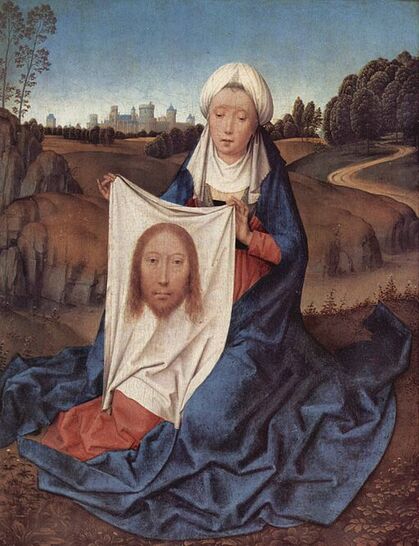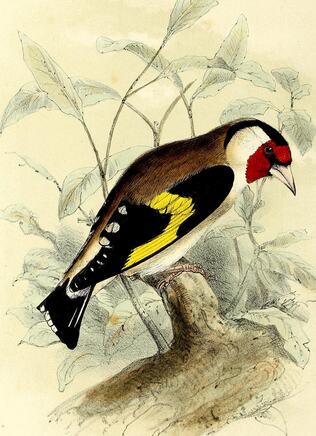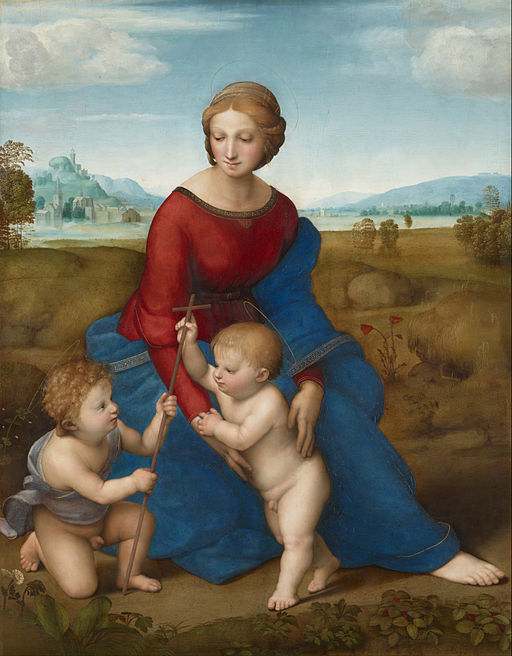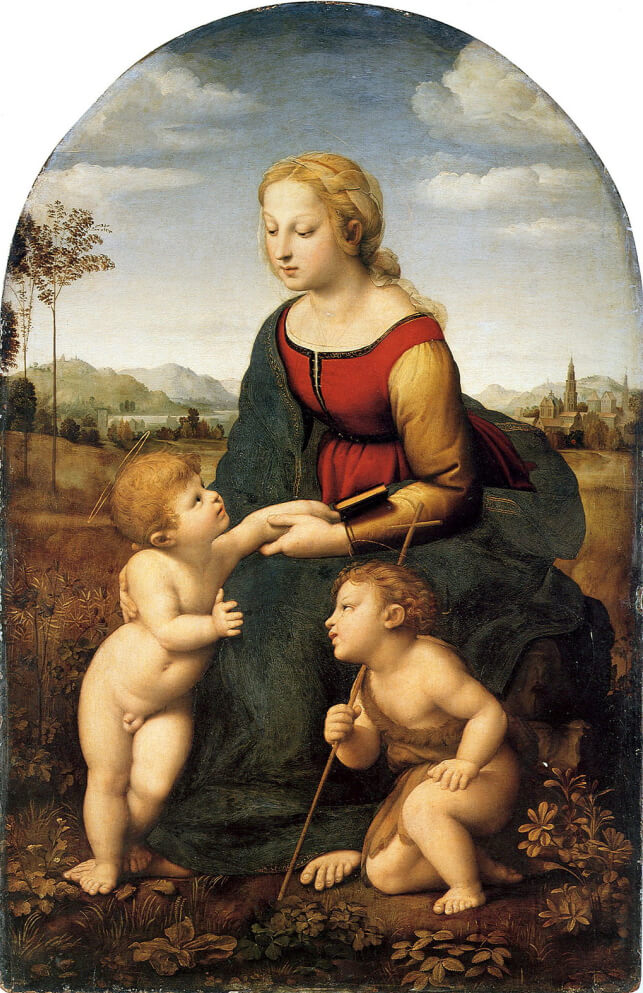|
Where? Room 41 of the Uffizi Museum
When? 1505-1506 Created for? A wedding gift of Raphael to his friend Lorenzo Nasi. What do you see? This painting – also known as Madonna del Cardellino – shows the Virgin Mary (referred to as the Madonna), Jesus, and Saint John. Mary sits on a rock and wears a red dress with a blue mantle on top of it. She protectively watches the two children in front of her. Saint John, the boy on the left with the gold curly hair, is dressed in animal skins. He holds a goldfinch bird in his hand. He wants to give the goldfinch to Jesus who is touching the head of the bird. Jesus is close to his mother and places his foot affectionately on his mother’s foot. The three figures in this painting are shown in a pyramidal form – known as the Renaissance triangle – a popular composition in the early Renaissance to represent symmetry in a painting. In the background, you can see a blue and green landscape with bushes, trees, hills, a river, a bridge, a castle, and some houses. Backstory: Raphael created this work for his close friend Lorenzo Nasi, a wealthy wool merchant from Florence. The painting shows the meeting between Saint John, Jesus, and Mary. This scene is based on a medieval religious text, Meditationes Vitae Christi (see a later translation here), which describes the Holy Family meeting Saint John in the desert on their way back from Egypt (a story not mentioned in the Bible). The composition of the work was directly inspired by the painting Saint Veronica by Hans Memling, which was created between 1470 and 1475. The clothes of Mary, the composition, and the city in the background are all elements that can also be seen in Memling’s painting. Raphael's painting deteriorated severely over time, and in May 1999 it was taken down for restoration. It took almost ten years to finish the restoration. In the meanwhile, a much-lower-quality copy of the painting was on display in the Uffizi Museum.
Symbolism: The Virgin Mary is dressed in red and blue. Red is a symbol of the passion of Christ and blue is the symbol of the Church and of Mary. It was one of the more expensive pigments and therefore appropriate to use for an important figure like Mary.
The European goldfinch is associated with the crucifixion of Jesus. In this painting, Saint John passes the bird on to Jesus as a forewarning of his violent death. From the book that Mary is holding, experts have identified the words “Sedes Sapientiae”. This is one of the devotional titles given to Mary and means “seat of wisdom”. It emphasizes that Mary gave birth to Jesus (who represents wisdom). When Mary is depicted in the role of the “seat of wisdom”, she is typically shown seated on a throne with Jesus in her lap. However, in this case, the rock on which Mary sits serves as the throne. Flowers: Several flowers can be seen in the painting. While not all flowers have been identified conclusively, many believe the flowers to be: anemones (representing Mary’s sorrow for the passion of Jesus), daisies (representing the innocence of Baby Jesus), plantains (representing the path to follow Jesus), and violets (representing humility).
Who is Raphael? Raffaello Sanzio da Urbino (1483-1520), popularly known as Raphael, was born in Urbino, a small city a few hours east of Florence. Together with Michelangelo and Leonardo da Vinci, he is considered one of the great masters of the Renaissance. He was a very talented architect, drawer, and painter, but is best known for his paintings of the Virgin Mary (called Madonnas) and his large-scale depictions of humans.
The Madonna of the Goldfinch was created during Raphael's period in Florence and shares many similarities with two other paintings of Raphael: the Madonna of the Meadow in the Kunsthistorisches Museum in Vienna and La Belle Jardinière in the Louvre. A few years later, in 1508, he moved to Rome where he completed many works for the Pope, such as the Portrait of Leo X with Two Cardinals.
Fun fact: IIn 1547, the house of the Nasi family, which was several feet away from the Ponte Vecchio, collapsed. Two of the occupants were killed and much of its decorations got damaged. Raphael's painting was also badly damaged. Battista Nasi, the son of Lorenzo Nasi, did all he could to retrieve the remainings of this painting as it was a very valuable asset of his father.
The painting had broken into six large pieces and even more smaller pieces. Battista could recover most pieces, except one large piece from the bottom left corner. The painting was restored by Ridolfo del Ghirlandaio, a good friend of Raphael. He did a great job in restoring the painting as this painting has become a very popular part of the Uffizi collection over the next centuries. Interested in a copy for yourself? Poster or canvas
Written by Eelco Kappe
References:
2 Comments
Lance
4/29/2020 05:33:18 pm
I have a painting of “The virgin with the Goldfinch”
Reply
Eelco Kappe
4/30/2020 09:37:27 am
Hi Lance,
Reply
Leave a Reply. |
Categories
All
|
- Home
- Blog
-
Museums
- Alte Pinakothek
- Art Institute of Chicago
- Baltimore Museum of Art
- Barber Institute of Fine Arts
- Bargello
- Barnes Foundation
- British Museum
- Church of Sant’Anastasia
- Cleveland Museum of Art
- Courtauld Institute of Art
- Detroit Institute of Arts
- Frans Hals Museum
- Galleria Borghese
- Gallerie dell'Accademia
- Getty Museum
- Guggenheim
- Hermitage Museum
- Kunsthistorisches Museum
- Kunstmuseum Basel
- Legion of Honor Museum
- Louvre
- Mauritshuis
- Metropolitan Museum of Art
- Musee d’Orsay
- Museum of Fine Arts in Boston
- Museum of Modern Art
- National Gallery in London
- National Gallery of Art
- National Museum in Poznań
- Norton Simon Museum
- Ny Carlsberg Glyptotek
- Palace of Versailles
- Palazzo Pitti
- Palazzo Vecchio
- Petit Palais
- Philadelphia Museum of Art
- Prado
- Pushkin Museum
- Ravenna Art Museum
- Rijksmuseum
- San Diego Museum of Art
- Santa Maria delle Grazie
- St. Peter's Basilica
- Städel Museum
- Statens Museum for Kunst
- Tate Britain
- Tate Modern
- Timken Museum of Art
- Uffizi
- Vatican Museums
- Wallace Collection
-
Artists
- Altdorfer
- Anguissola
- Berlin Painter
- Bosch
- Botticelli
- Boucher
- Bronzino
- Bruegel the Elder
- Brunelleschi
- Cabanel
- Caillebotte
- Canova
- Caravaggio
- Carpeaux
- Cezanne
- Cimabue
- David
- Degas
- Delacroix
- De Maria
- Donatello
- El Greco
- Fontana
- Fra Angelico
- Fragonard
- Gauguin
- Gentileschi
- Gericault
- Gonzalez-Torres
- Goya
- Hals
- Hogarth
- Hokusai
- Ingres
- Leonardo da Vinci
- Lippi, Filippo
- Longhi, Barbara
- Lorrain
- Makovsky
- Manet
- Massys
- Matisse
- Merian
- Michelangelo
- Mochi
- Modigliani
- Monet
- Panini
- Parmigianino
- Perugino
- Picasso
- Pisanello
- Raphael
- Rembrandt
- Renoir
- Reynolds
- Rivera
- Rodin
- Rubens
- Scultori
- Seurat
- Steen
- Tintoretto
- Titian
- Toulouse-Lautrec
- Turner
- Uccello
- Van der Weyden
- Van Dyck
- Van Eyck
- Van Gogh
- Van Hemessen
- Vasari
- Velazquez
- Vermeer
- Veronese
- Vigée Le Brun
-
Locations
- Books
- About Us

